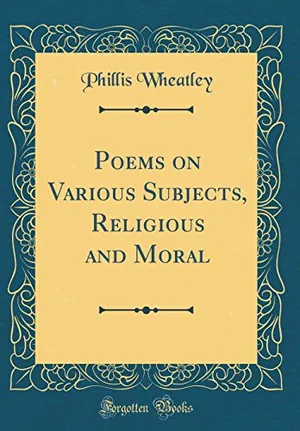How Phillis Wheatley Beat All Expectations
The Revolution-era Boston establishment couldn’t believe that the young African American woman wrote the exquisite book of poetry
:focal(1125x846:1126x847)/https://tf-cmsv2-smithsonianmag-media.s3.amazonaws.com/filer_public/b3/d1/b3d10ed5-030f-4670-81b2-9fbea0307328/janfeb2022_e01_prologue_composite.jpg)
Collection of the Smithsonian National Museum of African American History and Culture; background: VL1 / Shutterstock
Before Phillis Wheatley published her renowned collection Poems on Various Subjects, Religious and Moral in 1773, she’d had to withstand an interrogation by 18 men deemed “the most respectable characters in Boston.” Their task was to determine whether an enslaved girl, estimated to be about 18 or 19 years old at the time, had in fact written the poems herself, given widespread disbelief that a person like her—African, Black, female, young—could deliver such exquisite words. She passed the inspection with “flying colors,” the historian and literary critic Henry Louis Gates Jr. says in his 2003 book The Trials of Phillis Wheatley.
Born in present-day Senegal and Gambia and sold from there into bondage, Phillis arrived in the Boston docks in July 1761, likely 7 or 8 years old. The slave ship that brought her was the Phillis, which became her first name. As was the standard at the time, her surname was taken from her enslaver, a wealthy Boston merchant named John Wheatley, who intended Phillis to serve his wife, Susanna.
The young girl showed remarkable intellectual promise, and the Wheatleys provided her with instruction in several languages. She became proficient in the traditional Greek and Latin texts by age 12 and fell in love with the English poet Alexander Pope, modeling her own work after his. At just 13, she was published for the first time when Rhode Island’s Newport Mercury paper ran her poem about a near-shipwreck in 1767 (“Did Fear and Danger so perplex your Mind / As made you fearful of the Whistling Wind?”).
As Phillis’ prominence grew—her 1770 elegy for the Englishman George Whitefield, the influential early Methodist, was first published and sold by the Boston-born printer Ezekiel Russell—the Wheatleys sought a publisher for an anthology of her work. Yet Susanna Wheatley received no responses when she ran advertisements in the Boston papers in 1772, so the family pursued publishing options in Britain.
Phillis had accompanied John and Susanna’s son, Nathaniel, to London in 1771, where she’d encountered a series of impressive English patrons who took an interest in her work. Among them was Selina Hastings, Countess of Huntingdon, who supported abolition and was a patron of Rev. Whitefield, whom Wheatley had eulogized. The countess solicited the London publisher Archibald Bell to review the rest of the poet’s work. Bell said he would publish Wheatley but required proof that she’d written the poems herself. Thus, when she and Nathaniel returned to Boston, Wheatley faced her literary trial before those 18 arbiters, chosen for their status as gentlemen. Their attestation of the poems’ authenticity was included in the book, published nearly 11 months after the inquiry.
Likely under pressure from the poet’s wealthy English patrons, following the book’s publication, John Wheatley emancipated her. She sought to make a living through her writing, but the Revolutionary War intervened, diverting some of her patrons’ resources elsewhere. But her 1773 collection has continued to fascinate and delight successive generations with its themes of faith and salvation, wisdom and ignorance, enslavement and freedom. The poet Kevin Young, director of the Smithsonian’s National Museum of African American History and Culture, says Wheatley’s poems demonstrate that she was deeply attuned to the concerns of her day, often using allegory from her classics training, yet with a perspective inseparable from her African heritage and her experiences as a Black woman.
“She often embodies...these female gods and muses she invokes,” Young says, referring to Wheatley’s use of Greek mythological imagery. “She’s also protesting in many ways. When she’s talking about ‘Prometheus chained to the rock,’ she’s thinking about bondage. She’s thinking about creativity in bondage and the fire of existence.” As she writes in one poem:
Imagination! who can sing thy force?
Or who describe the swiftness of thy course?
Currently on view at NMAAHC, a much-loved edition of Poems on Various Subjects, Religious and Moral, with its brown leather cover and the occasional ink stain, reminds us why Wheatley’s words have persevered. The remainder of her life was undoubtedly tragic—without sponsors, she was unable to publish a proposed second anthology, and she lost multiple children in infancy after her marriage to John Peters, a free Black man. By her death in 1784 at just 31, she was impoverished and largely forgotten. Still, it remains deeply inspirational that, as Young says, Wheatley wrote “her way into freedom.”
*Editor's Note, 1/19/2022: An earlier version of this story stated that Phillis Wheatley was America’s first published African American poet. While Wheatley was the first African American poet to publish a collection, Jupiter Hammon had become the country’s first African American poet in 1761, when his poem 'An Evening Thought' ran in a New York newspaper.
A Note to our Readers
Smithsonian magazine participates in affiliate link advertising programs. If you purchase an item through these links, we receive a commission.
